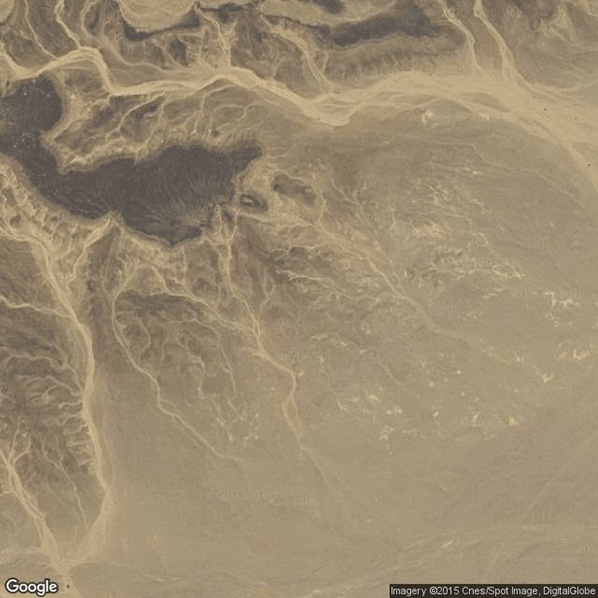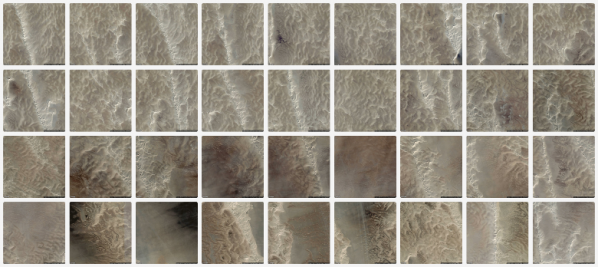



The new project by Guido Segni is so monumental in scope and so multitudinous in its implications that it can be a bit slippery to get a handle on it in a meaningful way. A quiet desert failure is one of those ideas that is deceptively simple on the surface but look closer and you quickly find yourself falling down a rabbit-hole of tangential thoughts, references, and connections. Segni summarises the project as an “ongoing algorithmic performance” in which a custom bot programmed by the artist “traverses the datascape of Google Maps in order to fill a Tumblr blog and its datacenters with a remapped representation of the whole Sahara Desert, one post at a time, every 30 minutes.”1
Opening the Tumblr page that forms the core component of A quiet desert failure it is hard not to get lost in the visual romanticism of it. The page is a patchwork of soft beiges, mauves, creams, and threads of pale terracotta that look like arteries or bronchia. At least this morning it was. Since the bot posts every 30 minutes around the clock, the page on other days is dominated by yellows, reds, myriad grey tones. Every now and then the eye is captured by tiny remnants of human intervention; something that looks like a road, or a small settlement; a lone, white building being bleached by the sun. The distance of the satellite, and thus our vicarious view, from the actual terrain (not to mention the climate, people, politics, and more) renders everything safely, sensuously fuzzy; in a word, beautiful. Perhaps dangerously so.
As is the nature of social media platforms that prescribe and mediate our experience of the content we access through them, actually following the A quiet desert failure Tumblr account and encountering each post individually through the template of the Tumblr dashboard provides a totally different layer to the work. On the one hand this mode allows the occasional stunningly perfect compositions to come to the fore – see image below – some of these individual ‘frames’ feel almost too perfect to have been lifted at random by an aesthetically indifferent bot. Of course with the sheer scope of visual information being scoured, packaged, and disseminated here there are bound to be some that hit the aesthetic jackpot. Viewed individually, some of these gorgeous images feel like the next generation of automated-process artworks – a link to the automatic drawing machines of, say, Jean Tinguely. Although one could also construct a lineage back to Duchamp’s readymades.


Segni encourages us to invest our aesthetic sensibility in the work. On his personal website, the artist has installed on his homepage a version of A quiet desert failure that features a series of animated digital scribbles overlaid over a screenshot of the desert images the bot trawls for. Then there is the page which combines floating, overlapping, translucent Google Maps captures with an eery, alternately bass-heavy then shrill, atmospheric soundtrack by Fabio Angeli and Lorenzo Del Grande. The attention to detail is noteworthy here; from the automatically transforming URL in the browser bar to the hat tip to themes around “big data” in the real time updating of the number of bytes of data that have been dispersed through the project, Segni pushes the limits of the digital medium, bending and subverting the standardised platforms at every turn.
But this is not art about an aesthetic. A quiet desert failure did begin after the term New Aesthetic came to prominence in 2012, and the visual components of the work do – at least superficially – fit into that genre, or ideology. Thankfully, however, this project goes much further than just reflecting on the aesthetic influence of “modern network culture”2 and rehashing the problematically anthropocentric humanism of questions about the way machines ‘see’. Segni’s monumental work takes us to the heart of some of the most critical issues facing our increasingly networked society and the cultural impact of digitalisation.
The Sahara Desert is the largest non-polar desert in the world covering nearly 5000 km across northern Africa from the Atlantic ocean in the west to the Red Sea in the east, and ranging from the Mediterranean Sea in the north almost 2000 km south towards central Africa. The notoriously inhospitable climate conditions combine with political unrest, poverty, and post-colonial power struggles across the dozen or so countries across the Sahara Desert to make it surely one of the most difficult areas for foreigners to traverse. And yet, through the ‘wonders’ of network technologies, global internet corporations, server farms, and satellites, we can have a level of access to even the most problematic, war-torn, and infrastructure-poor parts of the planet that would have been unimaginable just a few decades ago.
A quiet desert failure, through the sheer scope of the piece, which will take – at a rate of one image posted every 30 minutes – 50 years to complete, draws attention to the vast amounts of data that are being created and stored through networked technologies. From there, it’s only a short step to wondering about the amount of material, infrastructure, and machinery required to maintain – and, indeed, expand – such data hoarding. Earlier this month a collaboration between private companies, NASA, and the International Space Station was announced that plans to launch around 150 new satellites into space in order to provide daily updating global earth images from space3. The California-based company leading the project, Planet Labs, forecasts uses as varied as farmers tracking crops to international aid agencies planning emergency responses after natural disasters. While it is encouraging that Planet Labs publishes a code of ethics4 on their website laying out their concerns regarding privacy, space debris, and sustainability, there is precious little detail available and governments are, it seems, hopelessly out of date in terms of regulating, monitoring, or otherwise ensuring that private organisations with such enormous access to potentially sensitive information are acting in a manner that is in the public interest.
The choice of the Sahara Desert is significant. The artist, in fact, calls an understanding of the reasons behind this choice “key to interpret[ing] the work”. Desertification – the process by which an area becomes a desert – involves the rapid depletion of plant life and soil erosion, usually caused by a combination of drought and overexploitation of vegetation by humans.5 A quiet desert failure suggests “a kind of desertification taking place in a Tumblr archive and [across] the Internet.”6 For Segni, Tumblr, more even than Instagram or any of the other digitally fenced user generated content reichs colonising whatever is left of the ‘free internet’, is symbolic of the danger facing today’s Internet – “with it’s tons of posts, images, and video shared across its highways and doomed to oblivion. Remember Geocities?”7
From this point of view, the project takes on a rather melancholic aspect. A half-decade-long, stately and beautiful funeral march. An achingly slow last salute to a state of the internet that doesn’t yet know it is walking dead; that goes for the technology, the posts that will be lost, the interior lives of teenagers, artists, nerds, people who would claim that “my Tumblr is what the inside of my head looks like”8 – a whole social structure backed by a particular digital architecture, power structure, and socio-political agenda.

The performative aspect of A quiet desert failure lies in the expectation of its inherent breakdown and decay. Over the 50 year duration of the performance – not a randomly selected timeframe, but determined by Tumblr’s policy regulating how many posts a user can make in a day – it is likely that one or more of the technological building blocks upon which the project rests will be retired. In this way we see that the performance is multi-layered; not just the algorithm, but also the programming of the algorithm, and not just that but the programming of all the algorithms across all the various platforms and net-based services incorporated, and not just those but also all the users, and how they use the services available to them (or don’t), and how all of the above interact with new services yet to be created, and future users, and how they perform online, and basically all of the whole web of interconnections between human and non-human “actants” (as defined by Actor- network theory) that come together to make up the system of network, digital, and telecommunications technologies as we know them.
Perhaps the best piece I know that explains this performativity in technology is the two-minute video New Zealand-based artist Luke Munn made for my Net Work Compendium – a curated collection of works documenting the breadth of networked performance practices. The piece is a recording of code that displays the following text, one word at a time, each word visible for exactly one second: “This is a performance. One word per second. Perfectly timed, perfectly executed. All day, every day. One line after another. Command upon endless command. Each statement tirelessly completed. Zero one, zero one. Slave to the master. Such was the promise. But exhaustion is inevitable. This memory fills up. Fragmented and leaking. This processor slows down. Each cycle steals lifecycle. This word milliseconds late. That loop fractionally delayed. Things get lost, corrupted. Objects become jagged, frozen. The CPU is oblivious to all this. Locked away, hermetically sealed, completely focused. This performance is always perfect.”
Guido Segni’s A quiet desert failure is, contrary to its rather bombastic scale, a finely attuned and sensitively implemented work about technology and our relationship to it, obsolescence (planned and otherwise), and the fragility of culture (notice I do not write “digital” culture) during this phase of rapid digitalisation. The work has been released as part of The Wrong – New Digital Art Biennale, in an online pavilion curated by Filippo Lorenzin and Kamilia Kard, inexactitudeinscience.com.